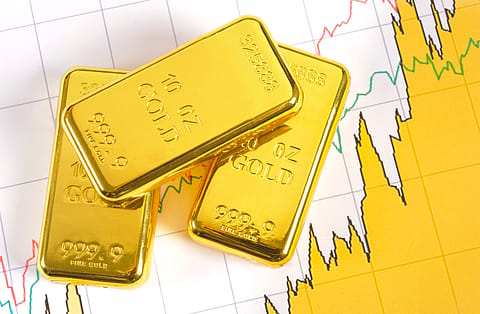Powell's dovish shift and lingering trade tensions boost gold outlook
Comex gold pulled back from its August highs as traders adopted a cautious stance ahead of Fed Chair Jerome Powell’s speech at the closely watched Jackson Hole Symposium.

Over the past month, Comex gold futures have largely traded rangebound amid shifting geopolitical, trade, and monetary policy dynamics that drive sentiment as prices initially retreated sharply from July’s peak of $3,450 to a one-month low of around $3,300 ahead of Trump’s August 1 tariff deadline.
The implementation of a 15% tariff on European goods, including autos and semiconductors, reduced safe-haven demand as the European Union simultaneously committed to purchase $750 billion in U.S. energy and military equipment. At the same time, the dollar strengthen as tensions between Trump and Federal Reserve Chair Powell over the central bank’s budgetary allocations drew attention and the Fed left interest rates unchanged.
In early August, gold reversal started as Trump announced fresh tariff measures ranging between 10% and 41% on imports from several countries, effective August 7, reignited global trade tensions, reviving safe haven flows into bullion. A weaker U.S. dollar, rising inflation expectations, and growing conviction that the Federal Reserve may be forced to cut rates also supported recovery. Market participants priced in a 94% probability of a September rate cut after soft labor market data and weak ISM services PMI signalled cooling momentum in the U.S. economy.
However, Gold’s rally gathered further pace after a Financial Times report indicated that one-kilogram bullion bars could face U.S. import tariffs. The development drove December Comex contracts to a seven-week high of $3,534 per ounce, with New York futures commanding a record premium of more than $100 over London spot prices. The sharp divergence echoed pandemic-era disruptions and underscored physical tightness. China also extended its central bank gold purchases for a ninth straight month in July, reinforcing underlying demand. Moreover, Swiss exports of gold to the U.S. surged to 51 tons in July, highest since March, after Trump imposed a 39% tariff on Swiss bullion highlighting gold demand.
Meanwhile, reports later suggested that the White House may clarify the tariff status on gold bar via executive order to ease concerns. Gold then started to retreat from highs as geopolitical risk premiums softened after Trump announced a meeting with Russian President Vladimir Putin on August 15 in Alaska to negotiate a potential peace framework in Ukraine.
He further assured on social media that “Gold will not be tariffed,” contradicting prior customs rulings. Elsewhere, the US extended its China tariff truce by 90 days, easing trade tensions and weighing on gold prices.
Comex gold pulled back from its August highs as traders adopted a cautious stance ahead of Fed Chair Jerome Powell’s speech at the closely watched Jackson Hole Symposium. However, prices surged past $3,420 following his remarks, after Powell signalled that the Federal Reserve may soon adjust its policy stance. While inflation concerns persist, he noted rising risks to the labor market, hinting at the possibility of a rate cut. Market expectations for a 25-basis-point cut in September have now surged to a 90% probability, up from below 70% prior to the speech.
Recommended Stories
Geopolitical tensions also continue to support safe-haven demand. Reports of intensified Russian strikes in Ukraine underscore unresolved global risks, further boosting gold’s appeal.
Gold is up over 29% year-to-date in 2025, buoyed by sustained central bank purchases, resilient ETF inflows, and persistent geopolitical uncertainty. In addition, President Trump’s trade rhetoric and ongoing friction with the Federal Reserve continue to fuel market unease, adding to gold’s attractiveness.
While short-term volatility is likely around upcoming policy announcements and tariff developments, the prospect of Fed easing remains the central catalyst for a renewed rally. With macro risks elevated, gold prices are expected to remain well-supported. Any pullback could present a strategic accumulation opportunity for investors positioning for a potential breakout above recent highs.
Technically, Comex Gold is holding key support at $3300, with a broader support zone between $3270- $3250. A breach below $3250 can lead the prices towards $3180 and $2970. On the upside, sustained momentum above $3435 can push prices beyond $3520 and could create new highs near $3650. On MCX, 98,000 is the key support area, while sustain above 99,450 could trigger a rally towards 1,01,800 and 1,03,600.
(INR CR)
During the last month, Comex silver surged to a 14-year high of above $39.90 per ounce before retreating amid progress in U.S. trade negotiations and the Fed’s July decision to hold rates unchanged weigh on prices. Moreover, strength in the U.S. dollar, rising yields, and profit-taking triggered 9% decline over seven sessions, while easing geopolitical tensions further weighed on sentiment. However, silver rebounded in early August, gaining over 7% to trade above $38, supported by weak U.S. jobs data, a softer dollar, and growing expectations of a Fed rate cut. However, following Fed Chair Powell’s Jackson Hole remarks, prices broke above $39 to one-month highs as silver remains underpinned by a persistent supply deficit, robust investor interest, and expanding industrial demand in solar, EVs, and electronics, keeping its long-term outlook positive.
(The author is Kaynat Chainwala, AVP - Commodity Research, Kotak Securities. Views are personal.)